Kamila B. Richter
Kamila B. Richter (born 2 May 1976 in Olomouc) is a Czech-German media artist. Richter lives and works in Düsseldorf and Karlsruhe. From 2000 to 2002 she lived in Durban and Johannesburg in South Africa and studied at the Technikon Natal, Durban. Previously, in 2001, she achieved the title of Master of Fine Arts and later, in 2010, the title of Doctor of Philosophy at the Academy of Fine Arts in Prague.
_-_Painting_(Oil_on_Canvas).jpg.webp)
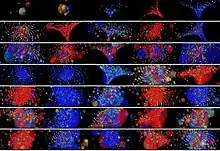
Richter B. Kamila | |
|---|---|
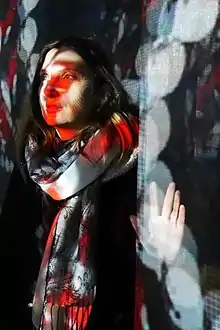 Kamila B. Richter | |
| Born | 2 May 1976 |
| Nationality | German |
| Education | Academy of Fine Arts Prague, Technikon Natal |
| Known for | New media art, Video art, performance, installation art, painter |
Life
As a programmer of the early web era (0-System, web project reflecting the medium of the web,
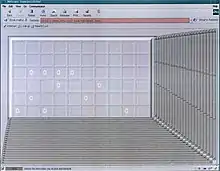
1997 and M-System, participatory web game project, 1998)[1] Kamila B. Richter is rendering the data streams visible which surround us on a daily basis (Emporium Spirit,[2] New York Stock Exchange visualization, 2005, Black Vortex, Prague Stock Exchange visualization, 2006, and others) and gives rise to the strings of zeros and ones, which invisibly plough through our daily communication, work and social life in exhibition spaces, where those data streams made visible meander, dislimn and resurge.[3]
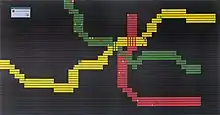
Since 2005 - in cooperation with Michael Bielický - she develops web based, often interactive projects, which are controlled by real time data fed from the Internet. Usually market and stock exchange data, news, Twitter and other data sources guide their animated stories - often in an uncanny and counterintuitive way. Most recently in Lost Objects, National Theatre Prague (2015)[4] and Lost, Apollonia, Strasbourg (2016).[5] In 2017 their solo exhibition LOST at the Centro de Arte Contemporáneo Wifredo Lam in Havana, Cuba ended after the second extension.[6]
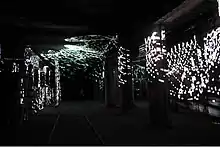
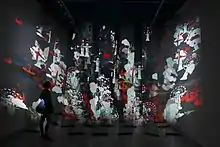
Since 2011 Kamila B. Richter uses technically out-dated mobile phones with low-resolution cameras, to capture the nightlife on the streets of European, Asian, South- and North-American cities, usually showing blurred silhouettes of human entities, often captured in backlight atmospheres of technically disintegrated surroundings. Kamila B. Richter is interested mainly in everything mediatised, the machine glare: the depiction of preconscious processes of sight, which our brain has learned to subconsciously construe. For Kamila B. Richter the camera’s blurred limited phase image is the proper reflection of reality. The abstract, mediatised reality as content and old master style oil painting technique, which she layers in weeklong work stages to finish her versions of mediatised streetscapes, materialize the tension of contemporary visual culture.[7]
Kamila B. Richter has participated in numerous international exhibitions, festivals and projects. Her innovative artworks shown worldwide include: Exhibitions on the Internet, Biennale Sevilla,[8] Museum Kunstpalast,[9] Telegrafenamt Vienna,[10] Art Center Nabi Seoul in South Korea,[11] the Künstlerhaus Vienna,[12] the DOX in Prague[13] and the ZKM Museum für Neue Kunst in Karlsruhe.[14]
Kamila B. Richter received the Master of Fine Arts title in 2001 and the Dr. Phil title at the Academy of Fine Arts (AVU) in Prague. She lived in Durban, Johannesburg, South Africa, and studied at the Technikon Natal, Durban. Today she lives and works in Düsseldorf and Karlsruhe.[14]
Exhibitions
Richter had a group exhibition at 2nd Zlín Youth Salon (2000).[15] And her first billboard projects in the city of Zlín, Czech Republic, titled Pure Love were exhibited as part of the 3rd Zlín Youth Salon (2003).[16] Later she continued with Guerilla public billboard projects in Prague, Czech Republic (2004). Her second major group exhibition was the seminal World as Structure, Structure as Image Exhibition at Gallery At the White Unicorn, Klatovy, Czech Republic in 2003[17] A retrospective of Richter's work in collaboration with Michael Bielicky was held at the Centro de Arte Contemporáneo Wifredo Lam in Havana, Cuba.[6] Her first major painting exhibition ended in September 2019.[7] A retrospective of Richter's work in collaboration with Michael Bielicky is held at the ZKM Karlsruhe until march 2020.[18]
Richter's work also appeared in seminal group exhibitions such as Biennale Moscow, Moscow (2011), Havana Biennale, Sevilla (2012), Globale, ZKM (2015) and Open Codes, ZKM (2017).
Literature
- Michaela Vlková. Internet Art vs. Art on the Internet. In: Umělec magazine 03/2000. Prague, PNS/Transpress/Kosmas. Pp. 44ff. ASIN B010I9C6VS
- Galerie Klatovy/Klenová (Ed.). Svět jako struktura, struktura jako obraz (World as Structure, Structure as Image). Galerie Klatovy, Klenová. 2003. ISBN 8085628813
- Pavel Liška (Ed.). HfBK Dresden - AVU Prag : Begegnung in Regensburg; zwei traditionsreiche Kunstakademien stellen sich vor. Museum Ostdeutsche Galerie, Regensburg. 2004. ISBN 3891881061
- Gemeinsam in Bewegung, Zeitgenössische Kunst aus Deutschland und China. Wuhan. Kunstverlag der Verlagsgruppe Yangtse, Provinz Hubei 2009. pp. 69 ff. ISBN 9787539430621
- Hans Belting, Andrea Buddensieg, Peter Weibel. Exhibition Catalogue: The Global Contemporary and the Rise of New Worlds. ZKM 2013. pp. 328 ff. ISBN 9780262518345
- Maria Christine Hoffer, Barbara Höller. Exhibition Catalogue: Time(less) signs, Contemporary Art in Reference to Otto Neurath. Künstlerhaus k/haus, Vienna 2013. pp. 106–107. ISBN 9783866787926
- Renate Buschmann, Darija Simunovic. Exhibition Catalogue: The Invisible Force Behind. Materiality in Media Art. Inter Media Art Institute, NRW-Forum. Düsseldorf 2014. pp. 28 ff. ISBN 9783862063871
- Davina Jackson. SuperLux, Smart Light Art, Design & Architecture for Cities. Thames & Hudson 2015. pp. 92 ff. ISBN 9780500343043
References
- Michaela Vlková. Internet Art vs. Art on the Internet. In: Umělec magazine 03/2000. Prague, PNS/Transpress/Kosmas. Pp. 44ff.
- Alexander Lang. Aesthetics in Information Visualization. Technical report, University of Munich, Department of Computer Science, 2010. p. 3.
- A. Ramirez Gaviria. When Is Information Visualization Art? Determining the Critical Criteria. Leonardo, 41(5):479–482, 2008.
- Michael Bielicky & Kamila B. Richter - Lost Objects. Official Prague National Theatre Site. Retrieved 14. August 2017.
- Dimitri Konstantinidis. e.city Prague 2016. Strasbourg, Apollonia. pp. 38-51. ISBN 9782918640059.
- Michael Bielicky & Kamila B. Richter – Exhibition "Lost" at the CAC Wifredo Lam . Arte por Excelencias website. Retrieved 29. October 2019.
- Kamila B. Richter – Exhibition "Divine Error" at the Zdeněk Sklenář at the Schönkirchovský palác. Official gallery website. Retrieved 29. October 2019.
- Davina Jackson. SuperLux, Smart Light Art, Design & Architecture for Cities. Thames & Hudson. 2015. pp. 92 ff. ISBN 9780500343043
- Darija Simunovic. Why Don’t We – A Modern Silent Movie. In: Renate Buschmann. The invisible force behind: Materialität in der Medienkunst; Quadriennale Düsseldorf, 2014. Dortmund, Kettler. 2014. pp. 28-35.
- Wagner Extase Festival. Wagner200 website. Retrieved 13. July 2018.
- Art Centre Nabi – passed projects (The Garden of Error and Decay Institution's own website. Retrieved 13. July 2018.
- Maria Christine Hoffer, Barbara Höller. Exhibition Catalogue: Time(less) signs, Contemporary Art in Reference to Otto Neurath. Künstlerhaus k/haus, Vienna 2013. pp. 106-107. ISBN 9783866787926
- Jaroslav Anděl (Hg.). DOX Centrum Současného Umění/Centre for Contemporary Art: Start: vydáno ku příležitosti inaugurační výstavy "Vítejte v Kapitalismu!" Centra Současného Umění DOX v Praze, 19.10.2008 - 8.2.2009. Prag, DOX Centre for Contemporary Art. 2008. S. 70 ff. & 114-115.
- Kamila B. Richter Artist Page. ZKM website. Retrieved 13. July 2018.
- 2nd Zlín Youth Salon – Exhibition Website. Zlinské salony website. Retrieved 18. July 2018.
- 3rd Zlín Youth Salon – Exhibition Website. Zlinské salony website. Retrieved 18. July 2018.
- Galerie Klatovy/Klenová (Ed.). Svět jako struktura, struktura jako obraz (World as Structure, Structure as Image). Galerie Klatovy, Klenová. 2003.
- Michael Bielicky - Perpetuum Mobile. ZKM Website. Retrieved 29 October 2019.